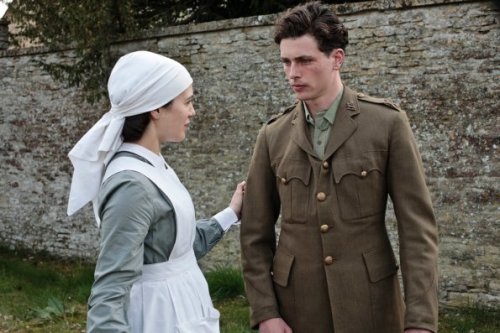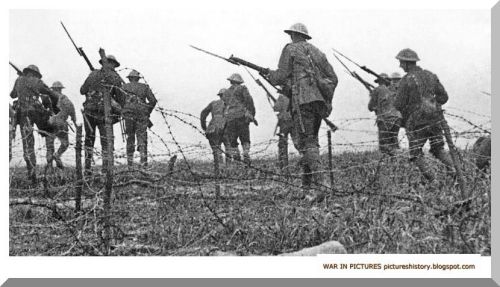Gentle readers, Downton Abbey, Season 2 will be shown on PBS through February 19, 2012. I will be writing a series of posts to help illuminate some historical details that might help the viewer who is not familiar with the events of this era. World War I’s connection to Jane Austen is poignant: soldiers in the trenches and those who were shell-shocked or recovering from injuries read Jane Austen’s novels to escape the horrors of war and relive a gentler, more civilized time.
Warning: Minor plot spoilers
Downton Abbey’s more somber subtext this season is due to the reality of war. Season 2 opens with Matthew Crawley at the Battle of the Somme in Northern France, which lasted from July through November, 1916, and symbolizes the horrors of World War One for the British.

Lady Sybil reads about the death of a male friend. Credit: Courtesy of © Carnival Film & Television Limited 2011 for MASTERPIECE
The Great War was supposed to have lasted only a few months in the minds of British Generals, who were accustomed to quickly overwhelming poorly armed native fighters in the colonies. But this deadly conflict, triggered by Germany as its troops marched through neutral Belgium to invade France (and which had been building up its cache of war equipment for a long time), lasted for more than 4 years. Casualties were so catastrophic that the numbers border on the unbelievable: Great Britain, 35.8% of the forces; France, 73.3%; Belgium, 34.9%; Germany, 64.9%; Austria/Hungary, 90%!
Of the over 65 million troops fighting in that war from all over the world, including India and North Africa, nearly 60% were killed or wounded (PBS). Add to this total the killing of innocent civilians and animals, the destruction of villages and farms in Belgium and Northern France, the enormous debt and resulting poverty that European nations faced, and one can only shake one’s head and wonder how the world could have plunged into a second world war a mere 30 years later.
Here then are only a few features of a war which is still remembered for its destructiveness one hundred years later
Barbed wire
The Battle of the Somme was supposed to have gone smoothly after the British artillery spent a week shelling German trenches. Bombardment commenced on July 1st, 1916 and could be heard across the Channel in Britain: 1,738,000 shells rained upon German territory. It was believed that such continuous and massive bombing would open up gaping holes in the barbed wire that protected enemy lines, allowing British cavalry to rush through and overwhelm the Germans who survived the destruction of their trenches. This did not happen. German trenches were dug much deeper than was thought and were not pulverized. To their horror, the English immediately realized that the barbed wire also remained largely intact. This meant that soldiers could not storm the battlefield, but would be fatally delayed as they tried to cut through the barriers, allowing machine gunners to mow them down. And this is what happened. Over 60,000 British troops were lost that first day. At the end of the campaign, the British had lost 420,000 men (the French 200,000 and the Germans 500,000).
Barbed wire had been used for the first time in the Spanish-American War and Boer Wars, but World War One brought its use in the battlefield to a new level. As soon as territory was conquered, a “wiring party” would go out to lay out barbed wire and protect their hard won land. Barbed wire was almost impossible to deal with until tanks were invented, although this piece of equipment was highly unreliable at first.
Modern weaponry
In my opinion, war has never been civilized or gentlemanly, but World War One raised the brutality to a new level that the stodgy British generals, in particular John French and Douglas Haig, were unable to fathom. The invention of machine guns allowed a single gunner to mow down hundreds of men within minutes. Flame throwers, known as Flammenwerfers in German, were portable and were first used by the Germans to terrify the British and French soldiers. The allies quickly learned to retaliate in kind.

Lady Sybil with soldier blinded by mustard gas. Credit: Courtesy of © Carnival Film & Television Limited 2011 for MASTERPIECE
In 1914, the French were the first to unleash poison gas on the enemy. This gas was more an irritant, much like pepper spray is regarded today, and did not maim or kill. In 1915, the Germans used chlorine gas on the unsuspecting British, which leads to a slow and torturous death by asphyxiation. There were other gases. Phosgene gas would first go unnoticed and by the time the damage was felt, it was too late to save the victim. Mustard gas caused blistering both on the face and inside the respiratory organs. Many who survived mustard gas were permanently blinded. The vagaries of the wind often carried gas back to the troops who had unleashed it on the enemy. Over time both sides learned to wear gas masks, providing them for their horses and messenger dogs as well. However, the gas cloud killed any animal indiscriminately – horses, birds, wildlife, rodents that happened to be in its path died horrible deaths. Airplanes made their first appearance, dropping bombs from the sky and on civilians, and the mortality rate of fighter pilots was extremely high, ranging in the suicidal. German U-boats (early submarines) were amazingly effective in sinking ships and preventing food and ammunitions from reaching the allies.
Trench Rats
The rats were as big as cats some soldiers swore. Millions infiltrated the trenches, running over sleeping men and raiding their pockets or foodstuffs. Rats swarmed the battlefields, feasting on rotting corpses, first going for the eyes, then gorging themselves on the rest of the body until their bellies were swollen.
There was no proper system of waste disposal in trench life. Empty tins of all kinds were flung away over the top on both sides of the trench. Millions of tins were thus available for all the rats in France and Belgium in hundreds of miles of trenches. During brief moments of quiet at night, one could hear a continuous rattle of tins moving against each other. The rats were turning them over.” – Private George Coppard, Royal West Surrey Regiment
Rats can multiply by the tens of thousands in no time (one pair can produce 880 offspring per year) and there was no way to escape them. Although ever present, soldiers never quite became inured to these bold, opportunistic rodents.

Matthew on leave, with his fiancee Lavinia Swire, greeting Sir Richard Carlisle. Credit: Courtesy of © Carnival Film & Television Limited 2011 for MASTERPIECE
In Downton Abbey Season 2 Matthew Crawley leaves the front and visits England quite frequently. The reality was that the men spent only part of their time in the trenches, rotating to different sectors. Typically they would spend 2 weeks in the trenches, a week in support lines or support trenches, two weeks in reserve, and then one week resting. Out of a year, a soldier would spend about 4 months in the front lines. This was about all they could stand. Living with the constant fear of death by shelling, sniper, or disease drove some men out of their minds. It must be added that as in all wars, the men spent countless days, even weeks, living lives of boredom which were interspersed with moments of sheer terror. The problem that many faced was that at any day their number could be up, and with odds worse than Russian Roulette, for there was a 1:3 chance that the next battle would be a British soldier’s last.

Thomas, now a medic, in the trenches. Credit: Courtesy of © Carnival Film & Television Limited 2011 for MASTERPIECE
Shell shock
A society known for its stiff upper lip would have a hard time admitting that its finest and brightest men could suffer from shell shock. During the early 20th century, shell shock was not yet clearly defined. Men suffering from shell shock exhibited a variety of symptoms, ranging from psychological blindness to stomach cramps and diarrhea, as well as facial twitches, uncontrollable sweating, nightmares, tremors, and an inability to eat or sleep. By 1917, as many as 1 in 7 men, or 80,000 British soldiers, were discharged from service for emotional disorders related to the war. Sadly, many were regarded as malingerers and sent back to the front. Some committed suicide, others deserted or refused to obey orders, in which case they were court-martialled or shot.
In Downton Abbey, Lord Grantham’s new valet, Andrew Lang obviously suffered from shell shock. O’Brien, Lady Grantham’s lady’s maid, shows uncharacteristic sympathy when she realizes Lange’s condition, because her brother suffered from the same malady and was misunderstood. Mrs. Patmore’s nephew, Archie, must also have experienced the same fear and panicked. He was not quite so lucky and was caught and shot for desertion.
Also read:
Life in the Trenches: Edwardian Promenade
Season 2, Episode One Recap on Austenprose
Please note: the ads at the bottom of my posts are wordpress ads. I make no money from my blog.
Images Credit: Courtesy of © Carnival Film & Television Limited 2012 for MASTERPIECE









